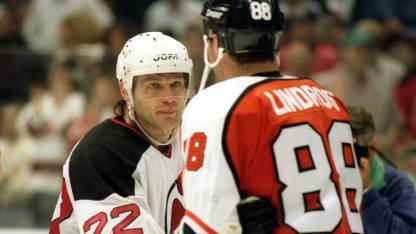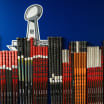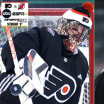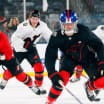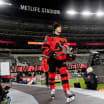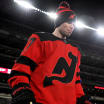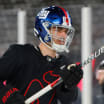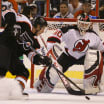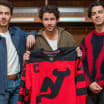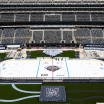Revenge.
That's the best single word to describe the New Jersey Devils' inspiration throughout the Garden Staters' 42-year rivalry with the Philadelphia Flyers.
The Broad Street Bullies began intimidating the expansion sextet from the Meadowlands almost from the first night the Devils took the ice in their maiden season, 1982-83.
New Jersey goalie Glenn (Chico) Resch, who eventually would play for both clubs, knew all about the Flyers. Resch had been a member of the 1980 Stanley Cup-winning NY Islanders in June 1980 when the Nassaumen defeated Philadelphia in a six-game Final round.
"The Flyers became the NHL's most notoriously tough team dating back to the mid-1970's when they won two Stanley Cups," Resch recalled. "They won by intimidation, whether it was with fighters like Dave Schultz or just nasty players like their captain Bobby Clarke. In the Devils' first year in New Jersey, Philly still was in a tough class by itself."
The Devils franchise as we now know it was two previous National Hockey League teams; first the Kansas City Scouts, later rechristened the Colorado Rockies. By that time the Flyers had become regarded as a skating collection of Darth Vaders with sticks. That image was further intensified when the Devils arrived in 1982 and opened their first season in East Rutherford.
Having won Stanley Cups in 1974 and 1975 the Flyers remained among the NHL elites into the new decade. By contrast the Devils - due to mismanagement in both Kansas City and Denver - were precariously short on talent.
"Offensively," said Resch, "we needed help."
Defense man Bob Lorimer who had skated for the 1980 Champ Islanders, was just as blunt.
"If anybody expects us to compete with the Islanders, Rangers or Flyers, they're crazy."
Philadelphia not only had won Stanley Cups but also a trip to the Final Round in 1976. Even when the Devils arrived in 1982, The City of Brotherly Love iced a most un-brotherly hockey club. Complaints to curb the Bullies excessive enthusiasm fell on deaf ears partly because fans filled arenas to see and hate them.
"I wanted a mean, rugged team that wouldn't be pushed around and would do the first pushing," Flyers owner Ed Snider told me. "When we came into the league, teams beat up on us for a couple of years and that's when I said, 'Enough, already, I want tough players.'"
By 1974, en route to their first championship, the Flyers boasted such bullies as Dave Schultz, - nicknamed "Hammer" for his fists - Bob Kelly - nicknamed "Hound" because he came at you like a mad dog - and a defenseman named Ed Van Impe who would just as soon put his stick in your stomach as he would on the puck
"We developed this intimidating image," said Van Impe, "because it wasn't just one or two of us who played a rough game, our battle level was high up and down to the last guy on the roster. If it wasn't me, it was the Hammer and if it was him it was Big Bird. (Don Saleski). Even our spare goalie, The Chief, could fight."
Mind you they didn't win two Cups with their fists. Artistic players such as Rick MacLeish, Bobby Clarke and Bill Barber put them over the top. Plus, Fred Shero was the right coach at the right time for them. He adlored a two-fisted team and encouraged belligerent play.
"We respected the Flyers on two counts " remembered then Devils rookie defenseman Ken Daneyko. "They knew how to play the game and they were tough."
In 1982-83, the Flyers led the Patrick Division with 49 wins and 106 points. The Devils finished the season with the fewest wins in the league and 48 points, a hefty 58 points less than the Broad Street Skaters.
"We knew we had a long way to go when it came to catching Philadelphia," said Devils owner Dr. John McMullen. "But we also knew that once we got stronger and tougher we'd be able to compete with the Flyers." Then, a pause: "Maybe even top them by winning a Cup. I was well aware that it wouldn't be easy and we had to be patient since we also were building through the Draft."
In 1982 New Jersey scored two Draft winners, Daneyko and forward Pat Verbeek; a year later it was John MacLean and Slava Fetisov and in 1984 a future captain in Kirk Muller. Interestingly, the same year that Verbeek and Daneyko were picked, the Flyers went for Ron Hextall at 119th.
In due time Hextall would play a major role in tossing gasoline on the rivalry fire.
"From the day Ronnie came into the league he showed that he liked a battle," Resch recalled, "and it didn't matter how tough the other guy happened to be."
But as it happened one of Hextall's first foes was not a New Jersey ruffian but rather a mild fellow who had no intentions of fighting on that particular night, January 24, 1987. Ironically, Original Devil Resch had been traded to Philly and now was starting the game for the Flyers. At the other end, Alain Chevrier was hoping to win a permanent goalkeeping job with New Jersey.
I was covering that game for SportsChannel and can say that night marked the beginning of the Devils-Flyers hate parade. The opening gun was a suckerpunch tossed by Hextall who - another bit of fistic irony - wasn't even the Philadelphia goalie that night. Hextall's right cross to Chevrier's proboscis was the opening blast.
Another witness was Noam Kogen, a Manhattan tax specialist, who had been watching the Devils since their first home game. As Kogen and I later agreed, the brawl that ensued really never should have happened since technically and officially the game was over.
It had ended with a 4-3 New Jersey win engineered by Chevrier's spectacular goaltending. Both Kogen and The Maven were equally amazed at what transpired after the final buzzer had blared across the arena.
Kogen: "The Devils skated out to congratulate Chevrier. Next came the three-star announcement but before it could be mentioned, Hextall precipitated a bench-clearing brawl before the teams could get to their locker rooms. It was a disgusting bit of intimidation by the Flyers and especially by Hextall."
But it also was right out of the Philly Bully Play Book. At 6-3, 205 pounds, Hextall towered over the tiny Chevrier who weighed in at 5-8, 180. Hextall piledrived his rival until peace could be restored. "What Hextall did was disgraceful," Kogen added, "and the rest of the Flyers weren't very gentlemanly either. Hextall may have thrown the punches but he gave the game of hockey a black eye as well."
In terms of the rivalry's evolution, the Pier Six Brawl had long-term significance because Hextall's manhandling of the smaller Chevrier convinced Devils ownership that the New Jersey lineup needed more muscle.
"I'm not suggesting that we have a team of goons," said owner Dr. John McMullen, "but I don't want to see us getting pushed around the way we did that night after beating the Flyers,"
In fact, McMullen started his toughen-up campaign in the spring of 1987 by hiring hard-nosed former Providence College sports director Lou Lamoriello to run hockey operations. "Lou will take the Devils franchise through the next stages of our development," added Dr. McMullen, "as well as the playoffs and the Stanley Cup."
I had lunch with Lamoriello that summer before the 1987-88 season began and already he was planning changes. "We have to get bigger and we have to get tougher," he said with a grin after sipping coffee, "and we have to make the playoffs."
From the broadcasters to the fans, everyone wondered about Lou's first move and who he'd obtain to minimize Philadelphia's dominance. As expected, he went for beef and signed 6-4, 220 pound forward Jim Korn and we all were delighted. It was more fun to produce games that featured two-fisted winners than perennial also-rans.
"Jim played for me at Providence," Lamoriello explained, "and he's been around the NHL so he knows what's needed and will deliver. First and foremost, he can handle himself."
In addition to Korn, Lou's new grit guys included David Maley - built exactly along Korn's lines - plus 1980 Olympic Gold Medal-winner Jack O'Callahan and a smallish but rugged duet, Perry Anderson and Claude Loiselle.
On October 27, 1987, the Devils - for a change - confronted Philadelphia with no fear. Fan Kogen was delighted. "Korn and Anderson were tough and beastly against the Flyers," he recalled. "So was little Pat Verbeek."
But Lou insisted that he was not merely building a competitive team, he wanted one that would be more aggressive against Philly than the one bench boss Doug Carpenter had been coaching. On January 26, 1988 he replaced Carpenter with Jim Schoenfeld, who had been a combative and competent defenseman and impressive behind the bench. Jim had a "Take No Prisoners" approach to hockey that appealed to Lou.
"There's a certain personality, a certain individual needed that can get us to where we can be or where we should be," said Lamoriello. "Jim Schoenfeld is the person I wanted."
With those moves, the Devils no longer would be regarded as the NHL's version of the 98-pound weakling who had sand kicked in his face by the league-bullying Flyers. A genuine rivalry was about to blossom and it would be filled with fury, fisticuffs and fancy play, all symbolizing the cross-state tension between them.
The following are solid samples of thrilling moments, listed in chronological order:
* OCTOBER 6, 1990: The Slovakian star Peter Stastny was one of Lou Lamoriello's important European additions. He proved his worth in this game alongside Kirk Muller. With the score tied 1-1, Statsny delivered a most perfect stretch pass to Muller who put the Devils ahead to stay, 3-1.
* JUNE 11, 1995: Game 5 of the 1995 Eastern Conference Final: New Jersey and Philly were tied at two games apiece and tied in the game as well. Late in the third period the Devils' Claude Lemieux fired a long shot from the right boards that beat Hextall to the left corner. It put the Devils ahead three games to two with Game 6 in East Rutherford.
* JUNE 13, 1995: Dr. McMullen led his trusty dog Bubba into the home clubhouse to celebrate the 4-2 victory over the Flyers. East Coast NHL bragging rights shifted from Pennsylvania to New Jersey as the Devils advanced to the Stanley Cup Final for the first time in club annals; and eventually on to the Stanley Cup with a four-game sweep of Detroit.
* MAY 24, 2000: Game 6 of the Eastern Conference Final reinforced the New Jersey-Pennsylvania competition. This nail-biter remained scoreless going into the third period. Once again, Flyers-killer Claude Lemieux scored along with series hero Alex Mogilny and the Garden Staters captured the pivotal contest, 2-1. Eric Lindros got the Philly goal.
* MAY 26, 2000: Although New Jersey had been down three games to one in the Eastern Conference Final, they rallied and forced a seventh game. In the third period, the 1-1 deadlock looked like it would stretch into overtime. But Patrik Elias scored his second of the match 2-1 and Larry Robinson's skaters leapfroged into the Final against Dallas. This time New Jersey would win its second Cup.
In addition to the classic games won by New Jersey, there were significant individual rivalries within the never-to-be-forgotten games. By far the most memorable featured Flyers mammoth forward Eric Lindros and Devils defenseman Scott Stevens.
At that time, Lindros was one of the most feared forwards of his era because of his size and willingness to use it against opponents. It had been refined in Junior hockey and became weaponized as a Flyer on a line with John Leclair and Mikael Renberg.
During the seventh game of the 2000 Eastern Conference Final, Lindros' weapon boomeranged on him. Because of his intimidating nature, Eric was able to gamble on stickhandling with his head down. "Eric knew that a lot of guys on the opposition would get out of his way," said former coach and analyst Don Cherry, "but that also could get him into trouble if he wasn't careful."
One of the hardest hits of all-time began as an innocent Lindros rush along the left boards. His mistake was deciding to cut to his right toward center ice where Stevens was waiting for him.
Cherry: "Eric had his head down when Scott came across like a freight train with his shoulder catching Lindros in the jaw. Eric's helmet went off and he hit his head on the ice. Boy, that guy Stevens really could hit."
New Jersey won the game, 2-1, and the series. And by defeating the Flyers - some critics said it was more like Stevens torpedoing Lindros - went on to win their second Stanley Cup.
Lindros never was the same intimidating force while Stevens captained New Jersey to the 2001 Final and a third Cup over Anaheim in 2003..
From a Philadelphia viewpoint, many games and hits factored into building the rivalry to white heat intensity. According to Joe Kadlec, the legendary - and first - Flyers public relations director, the Stevens whack job TKO on Lindros was at the top of the Hit List.
"Battles such as Stevens on Lindros were ugly to us because of what happened to Eric but that was all part of the rivalry," Kadlec asserted. "But there were so many other things like South Jersey vs Central Jersey."
"And our Stanley Cup-winning coach Fred Shero once was the Devils color man on radio. Then there were our heartbreaking losses, especially Claude Lemieux's winning goal in 1995 were part of it. Plus, just being in the same division and seeing each other in the playoffs so regularly just added to it."
Emmy Award winning hockey historian and veteran NHL reporter George Falkowski offers this historic perspective of what he labels "The Battle Of The Turnpike." He divides it into two parts; Chapter 1 encompasses the Devils 1995 gallop through Pennsylvania in order to win their first Cup over Detroit at Meadowlands Arena.
Falkowski: "One player dominated attention in each game and that was Claude Lemieux. Many people in the business think of him as a 'disturber,' which he was, but he had skill and the knack - and it is a knack - to deliver big in the clutch. In that Game 5 in 1995, it was hard to measure the shock value that Claude provided.
"The game was tied and just about everyone was preparing for a break - we needed it with all the excitement - and then the overtime. The shock value came about when 'Pepi' started his rush along the right boards. By the time he crossed his own blue line, Lemieux expected a Flyer to head him off at the pass and when he crossed into center, we figured he'd pass.
"But when he wound up to shoot it drew a yawn since he was off at such a ridiculous angle - and so far away - that it all looked like Claude was doing nothing more than killing the clock.
"But he was really killing the Flyers. After the puck zoomed past Hextall and in on the left side, it shocked the Flyers on their home ice and gave Jersey a three-games-to-two lead in the series."
The Maven liked that goal most of all because I happened to be standing behind Marty Brodeur and the Devils net when Lemieux took off on his expedition. I also was tickled because it set up Game 6 in New Jersey which the Devils annexed with relative ease.
My pal's preference was the Devils-Flyers series in the 2000 Eastern Conference Final. In that one, Philly grabbed what seemed to be an uncatchable 3-1 series lead. That's when the Devils rallied for a Game 5 road win and returned home with a chance to even the series.
Pal George remembers how Lemieux once again came to the rescue.
Falkowski: "The game was scoreless past the midway point of the third period. Just one well-placed shot or lucky bounce would send the Flyers to the Final. The tension at the Meadowlands was off the charts. With less than nine minutes left in regulation, Lemieux broke the ice and the backs of the Flyers by scoring the game's first goal.
"Five minutes later Alex Mogilny doubled the load. Eric Lindros scored for Philly with 29 seconds left but that was all; the series was tied. More important, it set the stage for the momentous Game 7. That included Scott Stevens' thundering hit on Lindros and Patrik Elias potting two goals including a last-second series-clincher in Game 7."
Thinking purely from the rivalry viewpoint, I asked Falkowski which Devils player Flyers fans most despised for the damage done to the Broad Streeters.
"Flyers fans groan and moan at the mention of names like Stevens, Elias and Brodeur but just say 'Claude Lemieux' and what comes next would make even the toughest Philly fan melt in a sea of tears - after cursing subtitles, of course!"
Another journalist with a 20-20 view of the rivalry intimately knows both sides. Mike (Doc) Emrick was a Flyers broadcaster first before he became play-by-play man for the Devils. When I asked Doc for his view of the rivalry, he put it this way:
Mike Emrick: For there to be a rivalry, you can’t have one team winning all the games. For 10 years, the Kansas City Scouts, Colorado Rockies, and Devils never won at the Spectrum.
*One night after his Flyers drilled the fledgling Scouts, Philadelphia, coach Fred Shero said, “I tried to help them. For once, I didn’t tell my players to not take stupid penalties.” Though the franchise had occasional home victories - very much like Pittsburgh and St. Louis – they suffered frustrating winless streaks in Philadelphia.
"That changed on November 29, 1984, a decade after the franchise began, when New Jersey finally walked up the ramp leaving the Spectrum to their bus with a 2-1 victory. The previous year, the Devils second year in New Jersey, they played the Flyers seven times and lost them all. Those early years were described by defenseman Dave Lewis as 'the best bunch of guys I ever played with who couldn’t win a hockey game.'
"But over the next decade, it became a rivalry with snarl. And it showed. 32 wins to 21 New Jersey (with some ties) leading up to the spring of ‘last 95 and the “proper” rivalry fuel —the first Devils-Flyers playoff series!
"And - though not favored against the Eric Lindros-led Flyers - the Devils won Games 1 and 2 and 5 at the Spectrum, the latter on Claude Lemieux’s long late game blast off Philadelphia Ron Hextall. They clinched in six at home with Lemieux again a force prompting the tabloid headline “Claude Reigns.” A sweep of Detroit brought the first set of rings.
"What brought vitriol into the rivalry was the historic comeback by New Jersey in 2000. The late season promotion of Larry Robinson to coach, and the respect the players had for him, became evident in the conference final with Philadelphia. After losing Game 4 at the Meadowlands to the Flyers 3-1, and falling behind in the series 3-1, the Hall of Famer Robinson went on a rare tirade in the dressing room. The Devils responded winning Game 5 in Philadelphia and Game 6 back in New Jersey. Electrified by their captain, Scott Stevens’ hit on Lindros in Game 7, Patrick Elias engineered a late game steal and the Devils completed an historic comeback,. At the time they were the first team to win a conference final after being behind 3-1.
"After the game, victorious goaltender Martin Brodeur told MSG interviewer, Matt Loughlin, 'even now, we still feel bad that we disappointed Larry so much.' The Devils went on to defeat Dallas for the second of their three Stanley Cups.
Not to be dominated by anyone, the Flyers paid back the Devils in 2004 and again in 2010, both times in first round series and both times in five games.
*When the Devils started in 1982, their games at the Meadowlands – which seated 19,040 – averaged a little over 7,000 per game, a figure which was jaundiced by sellouts when they played the Rangers. Games against the Flyers drew a large contingent of Philadelphia fans. But it took six years in New Jersey before the team got the credibility of being a playoff squad. And then, playoffs, and enhanced rivalries within the Eastern conference became a regular thing. A consistent thing. A Part of what I like to call the Devils 'Camelot years.'

